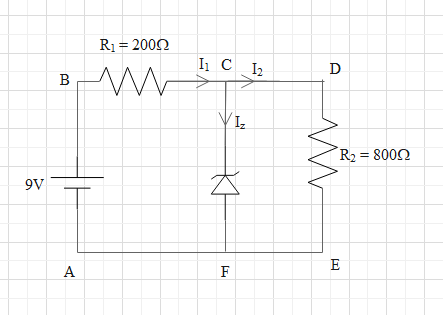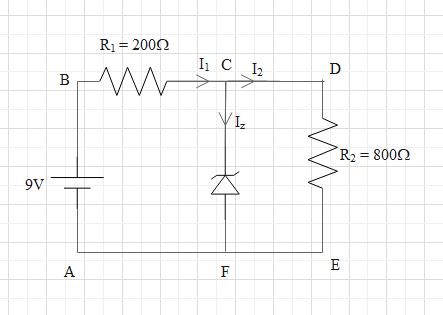Question
Question: The reverse breakdown voltage of a Zener diode is 5.6 V in the given circuit. The current \({{I}_{Z}...
The reverse breakdown voltage of a Zener diode is 5.6 V in the given circuit. The current IZ through the Zener is

A. 7mA
B. 17mA
C. 10mA
D. 15mA
Solution
Hint: Use Ohm’s law which gives us the equation V = IR. Kirchhoff's voltage law finds the current flowing in the two resistances. Once you find the current in the two resistances then use junction law to find IZ.
Formula used:
V = IR
Complete step by step answer:
Reverse breakdown voltage of a diode is the minimum voltage at which the diode starts to conduct electricity in reverse bias. Otherwise, in reverse biased a diode does not conduct electricity. In other words, it acts as an insulator.
Let the potential difference across the Zener diode be VZ.
Let the resistances 200Ω and 800Ω be R1 and R2 and let the potential differences across the resistances R1 and R2 be V1 and V2 respectively.
According to ohm’s law, V = IR.
Let the current passing through resistances R1 and R2 be I1 and I2.

Therefore, V1=I1R1 and V2=I2R2.
It is given that the current through the Zener diode is IZ.
Apply Khircoff’s voltage law in loop ABCF in the direction of current (clockwise direction).
Therefore, we get
9−I1R1−Vz=0.
It is given that Vz=5.6V and R1=200Ω. Substitute the value of Vz and R1 in the above equation.
This implies,
9−200I1−5.6=0.
⇒I1=2003.4=17×10−3A=17mA.
Again, apply Khircoff’s voltage law in loop CDEF in clockwise direction.
Hence we get,
Vz−I2R2=0.
It is given that R2= 800Ω. Substitute the value of R2 and Vz in the above equation.
This gives,
I2=8005.6=7×10−3A=7mA.
At point C, there is a junction of three currents, I1, I2 and Iz.
According to junction law of current, I1=I2+Iz
This gives us that Iz=I1−I2 …… (1).
We found the values of I1 and I2 equal to 17mA and 7mA respectively.
Substitute the values of I1 and I2 in equation (1).
Hence, Iz=17−7=10mA.
Therefore, the current flowing through the Zener diode is 10mA.
Hence, the correct option C.
Note: We can solve the question without knowing Kirchhoff's voltage law.
Assume the potential at the negative terminal of the battery is 0V. Then the potential at the positive terminal is 9V.
The potential difference across the Zener diode is 5.6V. Since the resistance of 800Ω is in parallel with the Zener diode it will have the same potential difference. Hence, the potential difference across the resistance is 5.6V. This means V2= 5.6V.
Therefore, I2=R2V2=8005.6=7×10−3A=7mA.
The potential at point F is 0V. The potential difference across the Zener diode is 5.6 V. Current always flows from higher potential to lower potential and when we go from point F to point C, we go in the opposite direction of the current. Hence, the potential will increase by an amount of 5.6V.
Therefore, the potential at point C is 5.6V.
This gives that the potential difference across resistance of 200Ω is 9 – 5.6 = 3.4V.
Hence, I1=R1V1=2003.4=17×10−3A=17mA.
At point C, the current I1 divides into two currents I2 and Iz. Hence, I1=I2+Iz.
